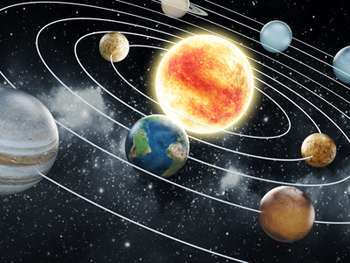
Plus Advent Calendar Door #9: Taming multitudes
On November 30 1889 Henri Poincaré, one of history's greatest mathematicians, found himself in an embarrassing situation. He had won a prestigious prize offered by King Oscar II of Sweden, and he'd just discovered a mistake in the piece of work he had won it for. Poincaré's manuscript was already being printed for presentation to the king and the world. To his credit, he sent word to immediately stop the presses.

Predicting the motion of more than three bodies is hard.
The prize King Oscar had offered concerned the motion of celestial bodies. Around 200 years earlier Isaac Newton had formulated his laws of motion and gravitation, which tell you how bodies such as planets and stars behave when they feel the gravitational pull of another body. Newton himself had applied his laws to predict what would happen in a solar system consisting of only two bodies. He justified what Johannes Kepler had claimed before him: that the less massive body (eg the Earth) will orbit the more massive one (eg the Sun) on a trajectory that is shaped like an ellipse.
King Oscar's prize challenged mathematicians to come up with a description of the motion of, not just two, but any number of bodies exerting a gravitational pull on each (see here for a precise description of the prize question). This being too hard, Poincaré had focussed on systems with exactly three bodies. The error he had found took about a month to fix, and even then Poincaré's work didn't provide a simple answer to the problem. As soon as more than two celestial bodies are involved, the task of describing their trajectories becomes very, very hard.
From planets to plasmas

Predator bluefin trevally sizing up schooling anchovies. Photo: Bruno de Giusti, CC BY-SA 2.5 IT.
A nuclear fusion reactor would heat a gas to incredibly high temperatures and subject it to a strong electromagnetic field to produce a plasma full of interacting charged particles. Understanding the behaviour of these particles is important. And this lands us right back in the situation that faced Poincaré: systems of many components, whether they interact through gravity or the electrostatic force, are extremely hard to understand. And if Poincaré struggled with three, then how are we to cope with the billions of particles that make up a plasma?
This was the problem tackled by a research programme at the Isaac Newton Institute for Mathematical Sciences in Cambridge. The idea is not to solve Poincaré's three-body problem or to build a nuclear fusion reactor (this is still some way out of reach but actively pursued by experiments such as the ITER in France). Instead, the aim is to develop the mathematics of kinetic theory, which would ultimately apply to any system consisting of a large number of moving components.
You can find out more about kinetic theory and the ideas explored at the INI research programme in this longer article.
Return to the Plus advent calendar 2022.
This article is part of our collaboration with the Isaac Newton Institute for Mathematical Sciences (INI), an international research centre and our neighbour here on the University of Cambridge's maths campus. INI attracts leading mathematical scientists from all over the world, and is open to all. Visit www.newton.ac.uk to find out more.
